Introduction
No volcanic eruption is believed to cause more or similar effects on the Earth relative to the Toba super-eruption. The Young Toba Tuff (YTT) is the latest series of about four eruptions that constitute the Toba volcanic event. YTT is believed to take place about seventy-four thousand years ago. Figure 1 depicts the event’s location in northern Sumatra, Indonesia1. The site records the occurrence of numerous enormous explosive volcanic eruptions in the past million years. YTT is considered the most recent and the worst of all the eruptions over the Pleistocene period1. The event’s production of numerous materials, for example, makes it significantly unique. Toba is believed to release a dense volcanic rock ranging between 2,800 and 5,300 cubic kilometers1, the largest volume in history.
Toba’s massive scale of volcanic material led to substantial effects on the Asian region, humans, climate, and the world. However, the real impact of the events remains unknown due to the several scientific controversies surrounding the matter and its true effect on the world and the global climate. Nonetheless, the world would be affected immensely if a volcanic eruption the size of Toba took place today2. Human lives would exhibit real change with the current state of the environment also changing substantially2. Thus, it is critical that such an event gets the right level of study and understanding among scholars, according to Rampino and Self1. Investigating Toba eruptions helps geologists comprehend major natural occurrences and forces that explain the past and several essential issues touching humanity. It also creates room for them to understand the major events’ causes and the potential of their reoccurrence.
The Toba explosions left behind several observable features that support their explosive nature. Its caldera’s size provides noteworthy information about the force making it. Moreover, it exists as part of the volcanic developments of the Sunda Arc, shown in figure 21. The repeatability and unmatched intensity of the eruptions at Toba makes the volcanic event unusual and worthwhile studying. The area’s topography exhibits a huge uplift recording a mean elevation of about fifteen thousand meters and lateral measurements of about 220 by 100 km, an area designated by blue spotted marks in Figure 31. The blue marks further depict the location of the Great Sumatran Fault Zone3, which indicates the unstable piece of crust resulting from the crumbling underground due to the tectonic plate movement. The circular caldera, the fault, cinder cones, and other physical features present in the Toba eruption’s site mark recent volcanic occurrences in the area.
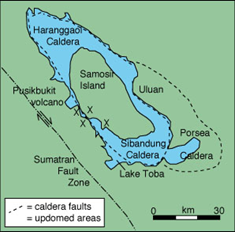
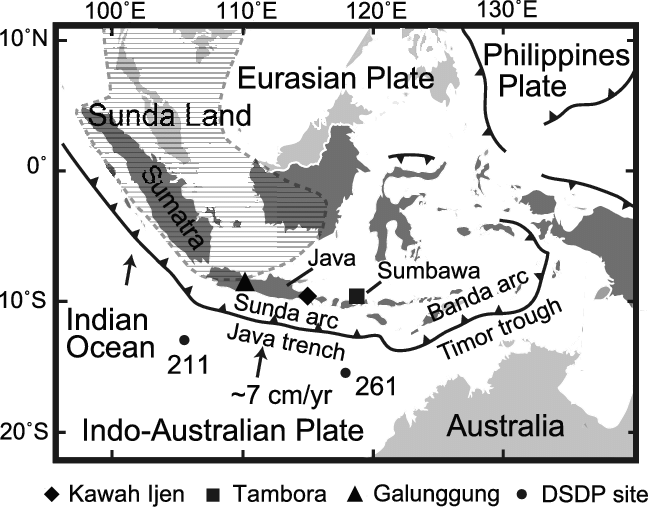
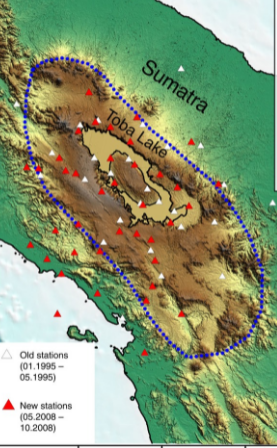
The massive amount of material released by the Toba eruption makes it a supervolcano. Osipov and colleagues define a supervolcano as a volcanic eruption exhibiting a VEI (Volcanic Explosivity Index) of 8, meaning the volcanic deposits of such an event are larger than one thousand cubic kilometers4. Toba’s dense volcanic rock emission ranges between 2,800 and 5,300 cubic kilometers3, thus, proving the event to be a super-eruption or supervolcano, the largest in the history of volcanic eruptions5. Supervolcanoes ensue due to the rising of magma into the crust from the mantle. The superhot magma cannot break through the crust, leading to pressure buildup due to the mounting magma pool until a point where the crust can no longer enclose the pressure4. The situation often occurs at hotspots, like in the Yellowstone Caldera, or subduction regions, like Toba.
Large-volume supervolcanic explosions are linked to huge igneous provinces that often cover vast spaces with volcanic ash and lava. The impact of such ashes and lava exhibit the potential to induce enduring climate modifications and threaten species’ extinction. The point that Toba is a supervolcano significantly links the explosion to the same effects. Toba led to numerous effects, including change in climate around Asia and the world and the famous volcanic winter that led to genetic bottleneck. Rampino and Self define ‘bottleneck’ as the severe reduction in the global population’s genetic due to the massive loss of the global population around fifty to one hundred thousand years ago due to catastrophe-related forces1. Volcanic eruptions release large volumes of ashes and Sulphur dioxide gas into the air, which reacts with the gases in the atmosphere to form Sulphates6. The combination of sulfates and volcanic ash, thus, occupies the atmosphere, obscuring and reflecting much of the rays from the sun, hence reducing global temperatures, leading to a volcanic winter.
The volcanic winter deprives the affected region’s capacity to produce adequate food and suitable environmental conditions for survival, therefore, leading to massive deaths of organisms, including humans6. Such effects are believed to occur during the Toba eruption, leading to a mean global temperature reduction of about ten degrees for years. The volcanic explosion and the resultant effects on the climate and humans make Toba’s subject very critical among scholars.
Some scholars’ linkage of the Toba eruption to the genetic bottleneck issue is, for instance, highly contested by others4. The debates concerning the issues of timing and the real quantity of the released material, particularly, make the Toba topic critical. Humans exhibit a high desire to comprehend the things that shaped their existence, and understanding the reality concerning Toba’s super-eruption stands to illuminate the matter. The present scientific report aims to analyze the real occurrences surrounding the Toba eruption. It also highlights some of the controversies touching on the topic to enable geologists and other interested scientists to get the facts about the matter.
Geological Setting of Toba
Toba sits at the boundary of two tectonic plates, the Indo-Australian and Eurasian plates, which form the Sunda arc. The oceanic plate at this point subducts almost diagonally to the continental plate at the rate of about fifty-six millimeters every year7. Ninkovich, Sparks, and Ledbetter say that caldera-forming eruptions are characteristics of subduction zones like the one in Toba7. Figure 4 offers a pictorial description of the occurrences of typical subduction zones. An oceanic plate is forced below a continental place, disrupting the magma stability at the point. The hot, disturbed, and displaced magma gets into the continental plate’s crust, where it is forced to the surface when the crust can no longer withhold the high mounting pressure within. An ocean trench is a common feature in the subduction zones like in the Toba region. The zones also form appropriate sites for earthquakes due to the excessive tension and shock caused by the moving tectonic plate.
Toba’s geographic situation makes it highly prone to explosive volcanoes. The area was particularly highly active during the Toba explosions several thousand years ago7. The explosions are linked to the volcanic winter that is believed to trigger genetic bottleneck between one hundred thousand and fifty thousand years ago1. The YTT was the latest and most dangerous of the Toba volcanic explosions. It is associated with the reduction of the global population to between one thousand and ten thousand, establishing the almost hour-glass population present on Earth today. However, due to the forever subsiding tectonic plate, the nature of the underlying rocks and the ever-present volcanic threat make the Indonesian volcanic region very critical to scholars.
Magma from the subducting plate travels about one hundred and fifty kilometers to reach the surface. The molten superhot rock at times develops reservoirs as big as 50,000 km3 within the overlapping crust. The long-distance, massive size of reservoirs, together with the heavy igneous rocks in the zone, makes the traveling magma high in pressure, thus, the explosive nature of the explosions within the locality7. As such, Toba receives the active-volcano classification due to the ever-present threat of explosion8. Toba falls under the ultra-Plinian eruptions, which feature the largest and most explosive eruptions with critical huge calderas forming above emptied magma cavities.
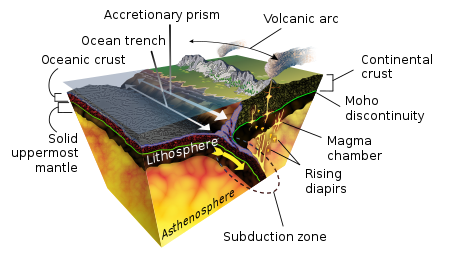
The Toba Super-Eruption
Toba’s eruption took place in four episodes, with the last explosion being the most severe. The eruption is recognized based on several features, including the unique horizontal ashfall for the YTT1. Toba registered the highest VEI of 8 and is regarded as the largest volcanic eruption of all times1. The eruption’s dense rock equivalent is approximated to be between two thousand and three thousand cubic kilometers, where about eight hundred cubic kilometers of the material settled on the Earth’s surface as ash2. Toba’s erupted mass was about twelve folds that of the 1815’s Tambora eruption in Indonesia, the most recent ‘largest’ eruption. The Tambora explosion is reported to induce a volcanic winter, in 1816, over the Northern Hemisphere, particularly in Southern Asia, which lacked summer over the period2.
Toba’s massive eruption further led to the deposition of fifteen centimeters thick ash layer over the South Asia region. Other areas covered by the Toba eruption ashes include the Indian Ocean region, the Sea at Southern China, and the Arabian Sea2. The realization of Toba’s ash in the South China deep-sea extends the recognized spread of the explosion, signifying that the formerly three thousand cubic kilometers estimation of the vented mass is an underestimate or the least possible value9. Moreover, the utilization of new methods now implies that the Toba Caldera Eruption perhaps released about 13,200 cubic kilometers in total volume. The new calculations, thus, lead to the labeling of the young the Youngest Toba discharge as a “VEI-9” event9. As such, Toba’s location along the ever-changing tectonic plates’ boundary implies a potential future explosion of the same margin, if not more.
The Consequences of the Catastrophe and the Debates
The Youngest Toba explosion was a supervolcanic outburst that took place around seventy-five thousand years in the past. The event’s location is the present-day Lake Toba’s site in Sumatra, Indonesia. The Toba explosion is one of the most known (explosive) eruptions in the world, leading to the famous Toba catastrophe theory9. The philosophy holds that the Toba explosion led to a worldwide volcanic winter lasting between six and ten years, and a one thousand years’ long chilling incident9. Ann Gibbons, an American science journalist, together with scholars like Michael Rampino (geologist), are the main supporters of the bottleneck theory associated with the Toba super-eruption.
Ann Gibbons, among several other scientists, maintain that a population bottleneck existed in humans’ evolution roughly seventy thousand years in the past. The event is linked to the massive eruption and its subsequent impact on the environment and the then climate10. Stephen Self also supports the theory of genetic bottleneck and its connection to the Toba explosion10. Self’s work further agrees with that of Stanley Ambrose, who in 1998 linked the Toba-related (global) volcanic winter to the massive death of humans leading to the genetic blockage. Like Ann Gibbons, many other scholars seeking information about human evolution and history posit that Toba is a major force in the shaping of humanity around the world.
However, the Toba catastrophe theory faces several contradictions from scholars who objected to the matter. Investigations into the theory by Gathorne-Hardy and Harcourt-Smith, for example, refute the point that Toba’s explosion’s effect exceeded 350 kilometers, as the Toba catastrophe theory posits. Gathorne-Hardy and Harcourt-Smith utilize the Mentawai islands’ data, collected using modern gadgets and methodology, to refute the theory advanced by the likes of Ann Gibbons. According to the two scientists, there is no way that Toba’s material would exceed the 350 kilometers distance and still lack effect on the Mentawai islands, that are several million years old12. As per the scholars, the study of the islands’ faunal remains indicates a consistent decay that is never disrupted by an external force like the settling of the volcanic dust on the islands.
Gathorne-Hardy and Harcourt-Smith’s academic review puts substantial doubts about the reported size of the Toba explosion. The possibility that the event never exhibited the reported size further implies its reduced size, which could not trigger the effects associated with the volcanic outburst13. Better still, Gathorne-Hardy and Harcourt-Smith utilize atmospheric temperature studies over the past years around the globe to imply a significant disconnect between the Toba explosions with the registered falling temperatures around the globe. According to the two scholars, the climatic condition regarding the temperature trends is a common thing that repeats itself several times in the world history12. The argument, therefore, disassociates the Toba explosion from the volcanic winter analogy and, in turn, presents the so-called superexplosion as a unique volcanic event, but which lack the much praise it receives from some scholars.
Moreover, Gathorne-Hardy and Harcourt-Smith refute the argument that the Toba super explosion caused a genetic bottleneck to the human population. The scientists utilize studies on the other mammals’ genetic development to argue that there is no way that Toba would affect humans and leave other more environment-sensitive organisms unaffected12. The absence of a perfect hour-glass-shaped population bottleneck among humans also suggests a failure by the Toba catastrophe philosophy, according to Gathorne-Hardy and Harcourt-Smith12. Consequently, Gathorne-Hardy and Harcourt-Smith provide noteworthy information, with scientific backing, to counter the arguments supporting the Toba catastrophe theory.
Smith, Jacobs, Johnsen, and colleagues’ argument also put more information to the debate associated with the Toba catastrophe theory. The scholars study the presence of the Toba explosion’s material in two archeological sites in South Africa, one of the locations believed to host humans during the Toba eruption13. The researchers provide information that both support, as well as cast doubts on the theory. For example, the scientists maintain that the humans present in South Africa by the time of the explosion were developed enough to adapt to different climatic conditions for survival12. The argument thus supports the refuting of the bottleneck analogy that implies that humans’ lack of adaptability led to massive deaths of people around the globe.
However, Smith, Jacobs, Johnsen, and colleagues’ argument that people in South Africa adapted successfully to the volcanic outburst tends to support the idea that a majority of the people living on Earth now exhibit their origin in Africa. The report, therefore, partly supports the bottleneck idea based on this argument14. However, the point that the report indicates significant stability of life in South Africa implies a possibility that life continued everywhere around the globe. South Africa is a relatively close point from Indonesia, as shown by Figure 5, and if people managed to survive there, then surviving elsewhere was easy15. However, the point that Smith and his colleagues fail to address some of the pertinent issues raised by Gathorne-Hardy and Harcourt-Smith, such as the issue of mammals and their protection from the eruption’s effects, makes the work less authoritative over the matter.
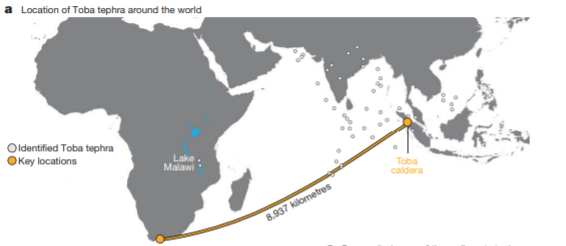
Conclusion
The Toba explosion attracts significant attention among many scientists due to several factors. However, the event’s connection to the human evolution topic makes it a significantly hot topic. The event’s material is reported to range between 2,800 and 5,300 cubic kilometers, making it the largest volume in history. The material consists of rocks, ashes, and Sulphur dioxide, which oxidized into sulfates in the atmosphere. The sulfates and the ashes in the skies formed a thick blanket that reflected a majority of the sun rays away from the earth’s surface, leading to volcanic winter that lasted for about ten years. The winter further triggered an imbalance in the atmospheric conditions that made life difficult for many existing humans then. The inability to survive further led to massive deaths that disturbed the normal distribution of the human genetic. Such a situation is explained by the so-called Toba catastrophe theory, supported by the likes of Ann Gibbons.
References
Rampino, M. R., and Self, S. (1992). Volcanic winter and accelerated glaciation following the Toba super-eruption. Nature. 359(6390), 50–52. Web.
Williams, M. (2012). Did the 73 ka Toba super-eruption have an enduring effect? Insights from genetics, prehistoric archaeology, pollen analysis, stable isotope geochemistry, geomorphology, ice cores, and climate models. Quaternary International 269, 87-93
Volcano Hazards Program. Volcanoes Can Affect Climate: Web.
Osipov, S., Stenchikov, G., Tsigaridis, K., LeGrande, A. N., Bauer, S. E., Fnais, M., and Lelieveld, J. (2021). The toba supervolcano eruption caused severe tropical stratospheric ozone depletion. Commun Earth Environ 2, 71. Web.
Cole-Dai, J. (2010). Volcanoes and climate. WIREs Clim Change 1, 824–839. Web.
Ledbetter, M. and Sparks, R. S. J. (1979) The Duration of Large-magnitude Silicic Eruptions Deduced from Graded Bedding in Deep-sea Tephra Layers. Geology 7, 240–244.
Ninkovich, D., Sparks, R. S. J., and Ledbetter, M. T. (1978). The exceptional magnitude and intensity of the Toba eruption, sumatra: An example of the use of deep-sea tephra layers as a geological tool. Bulletin Volcanologique, 41(3), 286–298. Web.
Ambrose, S. H. (2003). Did the super-eruption of Toba cause a human population bottleneck? Reply to Gathorne-Hardy and Harcourt-Smith. Journal of Human Evolution 45(3), 231–237. Web.
Williams, M. A. J., Ambrose, S. H., van der Kaars, S., Ruehlemann, C., Chattopadhyaya, U., Pal, J., and Chauhan, P. R. (2009). Environmental impact of the 73ka Toba super-eruption in South Asia. Palaeogeography, Palaeoclimatology, Palaeoecology, 284(3-4), 295–314. Web.
Williams, M. (2012). The ∼73 ka Toba super-eruption and its impact: History of a debate. Quaternary International 258, 19–29. Web.
Timmreck, C., Graf, H.-F., Zanchettin, D., Hagemann, S., Kleinen, T., and Krüger, K. (2012). Climate response to the Toba super-eruption: Regional changes. Quaternary International 258, 30–44. Web.
Gathorne-Hardy, F.., and Harcourt-Smith, W. E. (2003). The super-eruption of Toba, did it cause a human bottleneck? Journal of Human Evolution, 45(3), 227–230. Web.
Smith E.I., Jacobs Z., Johnsen, R., Ren, M., Fisher, E.C., Oestmo, S., Wilkins, J., Harris,J.A., Karkanas, P., Fitch, S., Ciravolo, A., Keenan, D., Cleghorn, N., Lane, C.S., Matthews T. and Marean, C.W. (2018) Humans Thrived in South Africa through the Toba Eruption About 74,000 Years Ago. Nature 555(7697), 511–515. Web.
Rampino, M., and Self, S. (1993). Climate-Volcanism Feedback and the Toba Eruption of ∼74,000 Years Ago. Quaternary Research 40(3), 269-280. Web.
Klein, R. G. (2019) Population Structure and the Evolution of Homo Sapiens in Africa. Evolutionary Anthropology: Issues, News, and Reviews, 28(4), 179–188. Web.
Dateandtime. (n.d). Distance between Toba, Serbia and other cities. Web.